BHO6505 Case Analysis: SUV Advertisements and Family Structures
VerifiedAdded on 2022/09/15
|9
|2611
|14
Case Study
AI Summary
This case study analyzes the effectiveness of SUV advertisements in Australia, considering the changing demographics and family structures. The paper examines whether SUV ads reflect reality by focusing on local communities and modern societies, and evaluates the impact of the changing Australian population on marketing strategies. It discusses the disadvantages of focusing on traditional family structures in advertisements and explores alternative marketing approaches, such as targeting the youth with sports car advertisements. The study reveals the types of people marketers use in television commercials for sports cars, and concludes by summarizing the key findings and implications for marketing practices. The paper also highlights the importance of adapting marketing messages to reflect contemporary societal changes and consumer preferences.
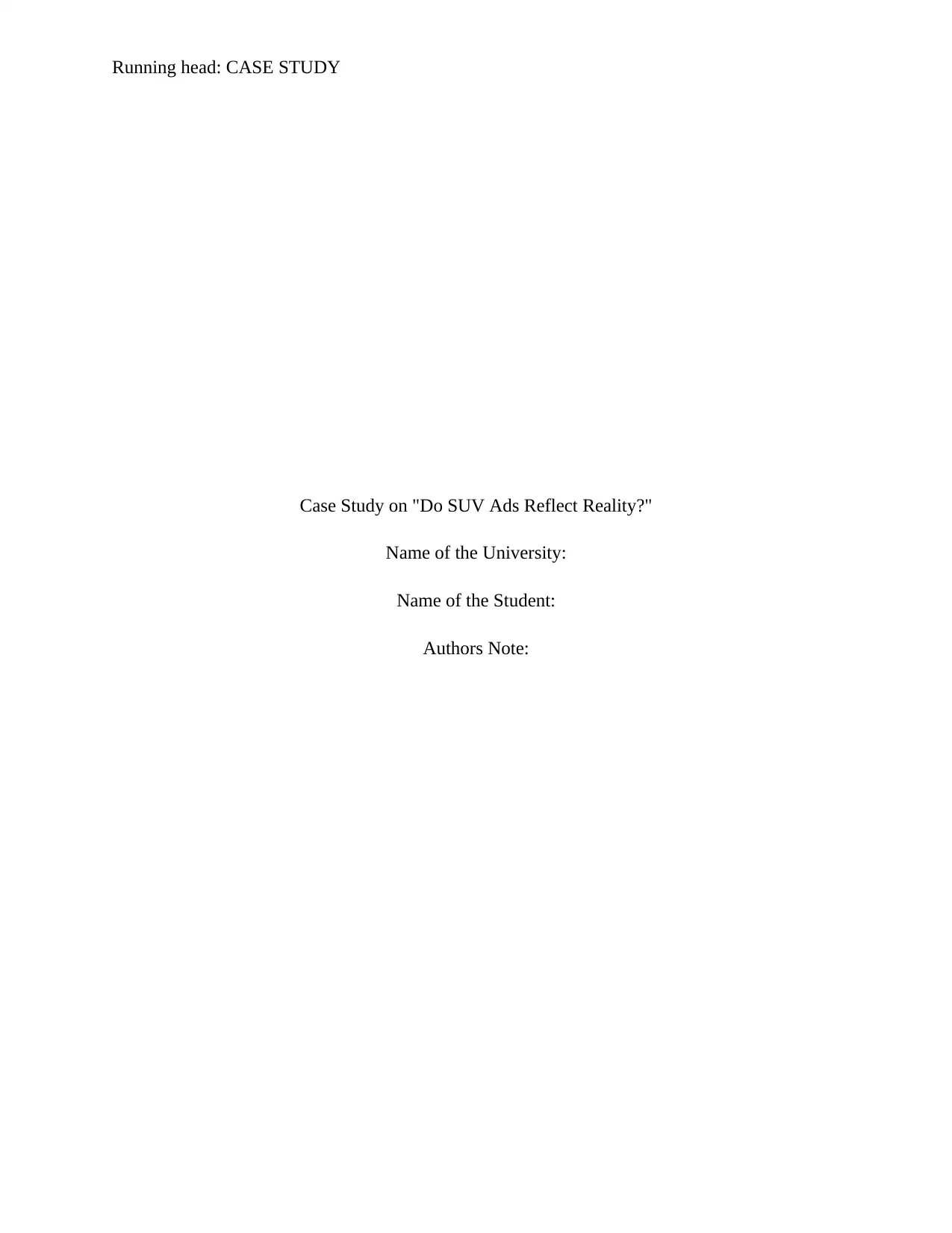
Running head: CASE STUDY
Case Study on "Do SUV Ads Reflect Reality?"
Name of the University:
Name of the Student:
Authors Note:
Case Study on "Do SUV Ads Reflect Reality?"
Name of the University:
Name of the Student:
Authors Note:
Paraphrase This Document
Need a fresh take? Get an instant paraphrase of this document with our AI Paraphraser
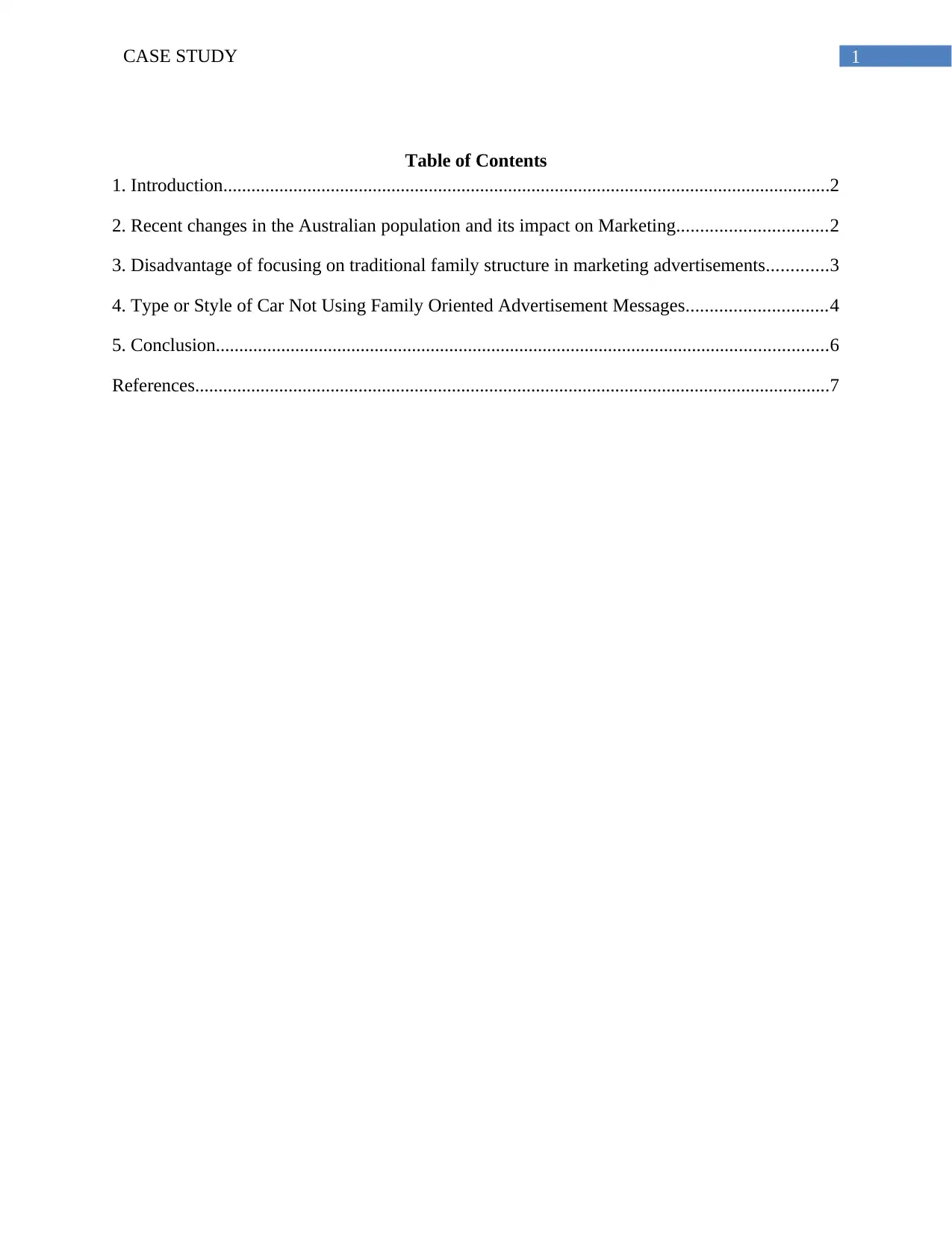
1CASE STUDY
Table of Contents
1. Introduction..................................................................................................................................2
2. Recent changes in the Australian population and its impact on Marketing................................2
3. Disadvantage of focusing on traditional family structure in marketing advertisements.............3
4. Type or Style of Car Not Using Family Oriented Advertisement Messages..............................4
5. Conclusion...................................................................................................................................6
References........................................................................................................................................7
Table of Contents
1. Introduction..................................................................................................................................2
2. Recent changes in the Australian population and its impact on Marketing................................2
3. Disadvantage of focusing on traditional family structure in marketing advertisements.............3
4. Type or Style of Car Not Using Family Oriented Advertisement Messages..............................4
5. Conclusion...................................................................................................................................6
References........................................................................................................................................7
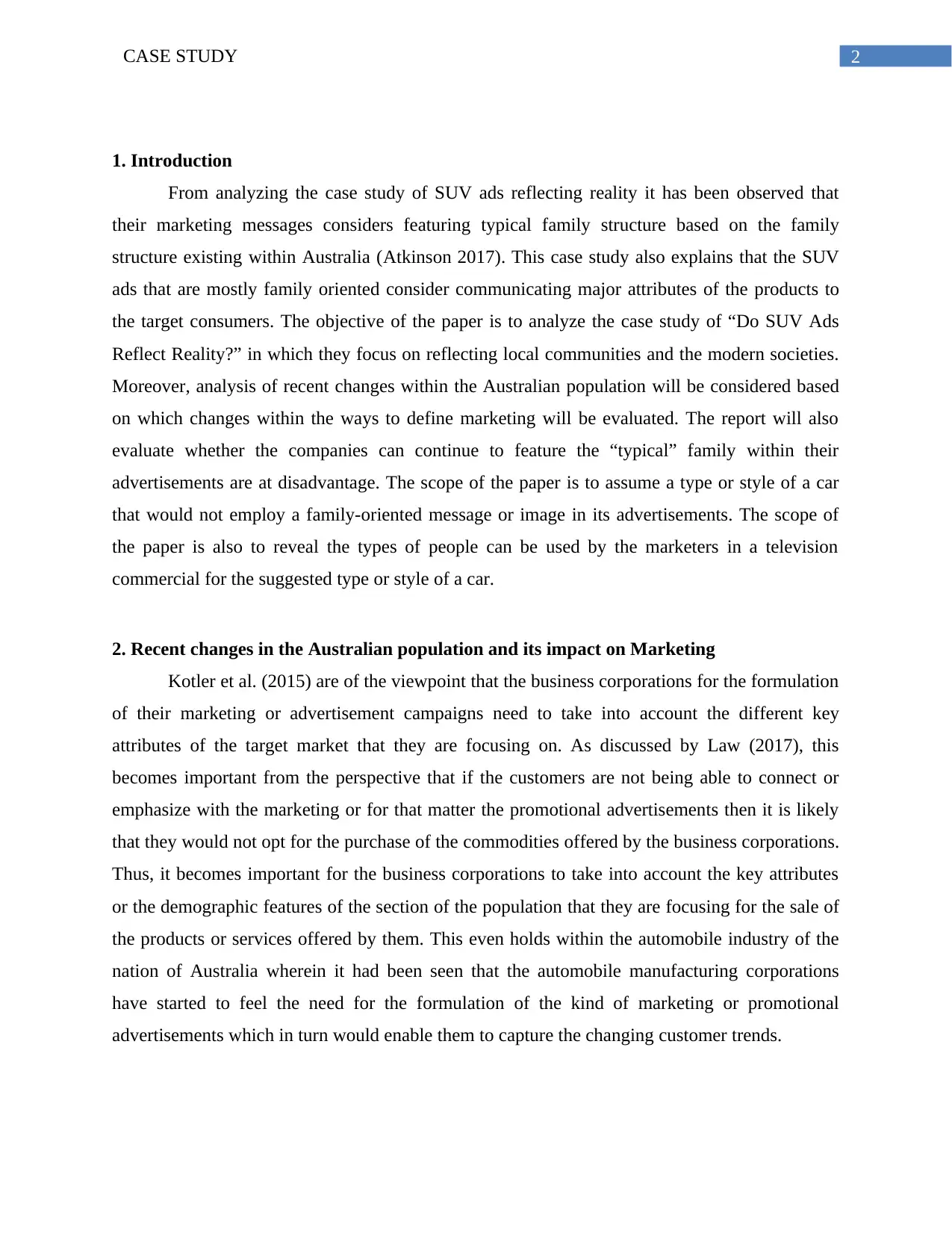
2CASE STUDY
1. Introduction
From analyzing the case study of SUV ads reflecting reality it has been observed that
their marketing messages considers featuring typical family structure based on the family
structure existing within Australia (Atkinson 2017). This case study also explains that the SUV
ads that are mostly family oriented consider communicating major attributes of the products to
the target consumers. The objective of the paper is to analyze the case study of “Do SUV Ads
Reflect Reality?” in which they focus on reflecting local communities and the modern societies.
Moreover, analysis of recent changes within the Australian population will be considered based
on which changes within the ways to define marketing will be evaluated. The report will also
evaluate whether the companies can continue to feature the “typical” family within their
advertisements are at disadvantage. The scope of the paper is to assume a type or style of a car
that would not employ a family-oriented message or image in its advertisements. The scope of
the paper is also to reveal the types of people can be used by the marketers in a television
commercial for the suggested type or style of a car.
2. Recent changes in the Australian population and its impact on Marketing
Kotler et al. (2015) are of the viewpoint that the business corporations for the formulation
of their marketing or advertisement campaigns need to take into account the different key
attributes of the target market that they are focusing on. As discussed by Law (2017), this
becomes important from the perspective that if the customers are not being able to connect or
emphasize with the marketing or for that matter the promotional advertisements then it is likely
that they would not opt for the purchase of the commodities offered by the business corporations.
Thus, it becomes important for the business corporations to take into account the key attributes
or the demographic features of the section of the population that they are focusing for the sale of
the products or services offered by them. This even holds within the automobile industry of the
nation of Australia wherein it had been seen that the automobile manufacturing corporations
have started to feel the need for the formulation of the kind of marketing or promotional
advertisements which in turn would enable them to capture the changing customer trends.
1. Introduction
From analyzing the case study of SUV ads reflecting reality it has been observed that
their marketing messages considers featuring typical family structure based on the family
structure existing within Australia (Atkinson 2017). This case study also explains that the SUV
ads that are mostly family oriented consider communicating major attributes of the products to
the target consumers. The objective of the paper is to analyze the case study of “Do SUV Ads
Reflect Reality?” in which they focus on reflecting local communities and the modern societies.
Moreover, analysis of recent changes within the Australian population will be considered based
on which changes within the ways to define marketing will be evaluated. The report will also
evaluate whether the companies can continue to feature the “typical” family within their
advertisements are at disadvantage. The scope of the paper is to assume a type or style of a car
that would not employ a family-oriented message or image in its advertisements. The scope of
the paper is also to reveal the types of people can be used by the marketers in a television
commercial for the suggested type or style of a car.
2. Recent changes in the Australian population and its impact on Marketing
Kotler et al. (2015) are of the viewpoint that the business corporations for the formulation
of their marketing or advertisement campaigns need to take into account the different key
attributes of the target market that they are focusing on. As discussed by Law (2017), this
becomes important from the perspective that if the customers are not being able to connect or
emphasize with the marketing or for that matter the promotional advertisements then it is likely
that they would not opt for the purchase of the commodities offered by the business corporations.
Thus, it becomes important for the business corporations to take into account the key attributes
or the demographic features of the section of the population that they are focusing for the sale of
the products or services offered by them. This even holds within the automobile industry of the
nation of Australia wherein it had been seen that the automobile manufacturing corporations
have started to feel the need for the formulation of the kind of marketing or promotional
advertisements which in turn would enable them to capture the changing customer trends.
⊘ This is a preview!⊘
Do you want full access?
Subscribe today to unlock all pages.

Trusted by 1+ million students worldwide
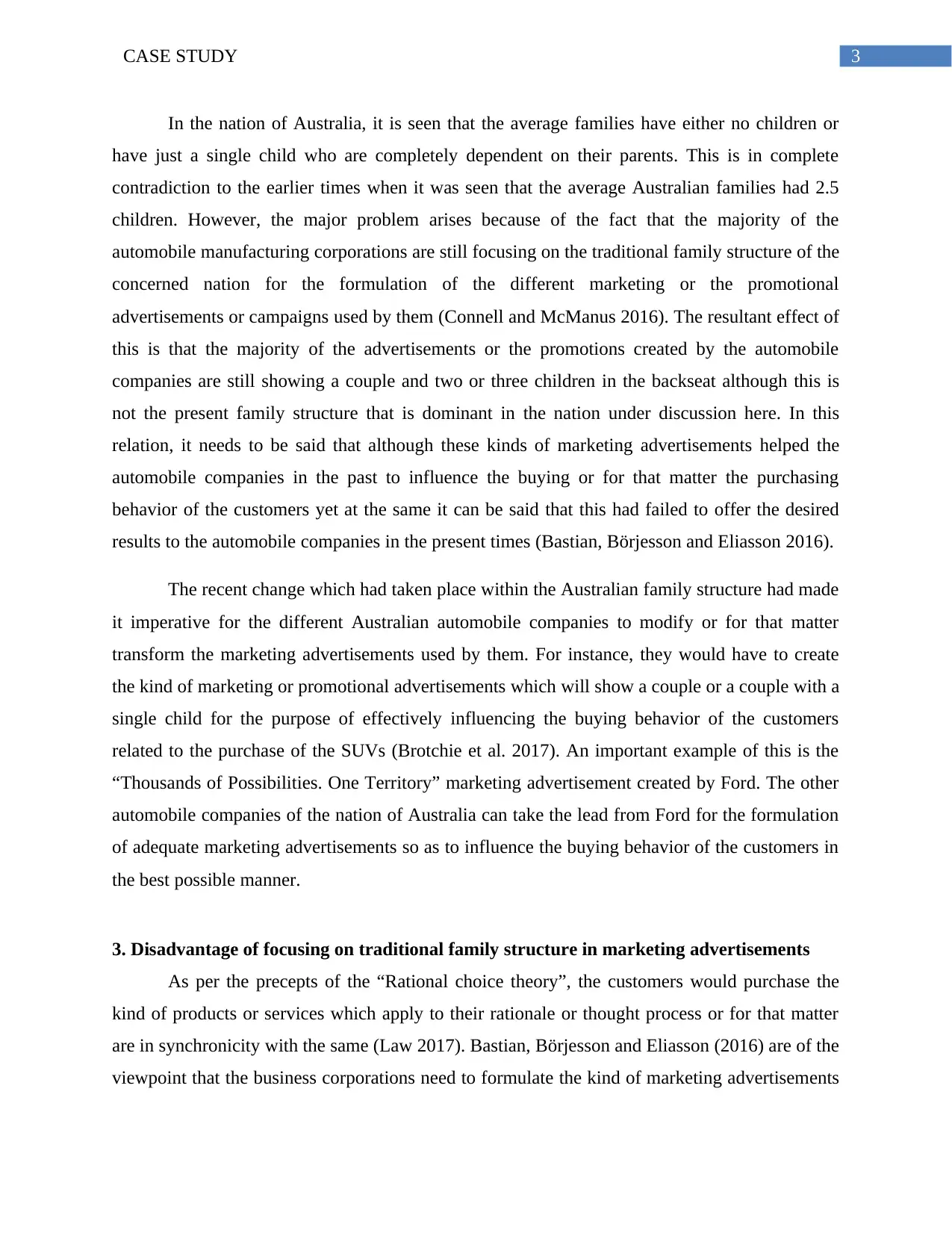
3CASE STUDY
In the nation of Australia, it is seen that the average families have either no children or
have just a single child who are completely dependent on their parents. This is in complete
contradiction to the earlier times when it was seen that the average Australian families had 2.5
children. However, the major problem arises because of the fact that the majority of the
automobile manufacturing corporations are still focusing on the traditional family structure of the
concerned nation for the formulation of the different marketing or the promotional
advertisements or campaigns used by them (Connell and McManus 2016). The resultant effect of
this is that the majority of the advertisements or the promotions created by the automobile
companies are still showing a couple and two or three children in the backseat although this is
not the present family structure that is dominant in the nation under discussion here. In this
relation, it needs to be said that although these kinds of marketing advertisements helped the
automobile companies in the past to influence the buying or for that matter the purchasing
behavior of the customers yet at the same it can be said that this had failed to offer the desired
results to the automobile companies in the present times (Bastian, Börjesson and Eliasson 2016).
The recent change which had taken place within the Australian family structure had made
it imperative for the different Australian automobile companies to modify or for that matter
transform the marketing advertisements used by them. For instance, they would have to create
the kind of marketing or promotional advertisements which will show a couple or a couple with a
single child for the purpose of effectively influencing the buying behavior of the customers
related to the purchase of the SUVs (Brotchie et al. 2017). An important example of this is the
“Thousands of Possibilities. One Territory” marketing advertisement created by Ford. The other
automobile companies of the nation of Australia can take the lead from Ford for the formulation
of adequate marketing advertisements so as to influence the buying behavior of the customers in
the best possible manner.
3. Disadvantage of focusing on traditional family structure in marketing advertisements
As per the precepts of the “Rational choice theory”, the customers would purchase the
kind of products or services which apply to their rationale or thought process or for that matter
are in synchronicity with the same (Law 2017). Bastian, Börjesson and Eliasson (2016) are of the
viewpoint that the business corporations need to formulate the kind of marketing advertisements
In the nation of Australia, it is seen that the average families have either no children or
have just a single child who are completely dependent on their parents. This is in complete
contradiction to the earlier times when it was seen that the average Australian families had 2.5
children. However, the major problem arises because of the fact that the majority of the
automobile manufacturing corporations are still focusing on the traditional family structure of the
concerned nation for the formulation of the different marketing or the promotional
advertisements or campaigns used by them (Connell and McManus 2016). The resultant effect of
this is that the majority of the advertisements or the promotions created by the automobile
companies are still showing a couple and two or three children in the backseat although this is
not the present family structure that is dominant in the nation under discussion here. In this
relation, it needs to be said that although these kinds of marketing advertisements helped the
automobile companies in the past to influence the buying or for that matter the purchasing
behavior of the customers yet at the same it can be said that this had failed to offer the desired
results to the automobile companies in the present times (Bastian, Börjesson and Eliasson 2016).
The recent change which had taken place within the Australian family structure had made
it imperative for the different Australian automobile companies to modify or for that matter
transform the marketing advertisements used by them. For instance, they would have to create
the kind of marketing or promotional advertisements which will show a couple or a couple with a
single child for the purpose of effectively influencing the buying behavior of the customers
related to the purchase of the SUVs (Brotchie et al. 2017). An important example of this is the
“Thousands of Possibilities. One Territory” marketing advertisement created by Ford. The other
automobile companies of the nation of Australia can take the lead from Ford for the formulation
of adequate marketing advertisements so as to influence the buying behavior of the customers in
the best possible manner.
3. Disadvantage of focusing on traditional family structure in marketing advertisements
As per the precepts of the “Rational choice theory”, the customers would purchase the
kind of products or services which apply to their rationale or thought process or for that matter
are in synchronicity with the same (Law 2017). Bastian, Börjesson and Eliasson (2016) are of the
viewpoint that the business corporations need to formulate the kind of marketing advertisements
Paraphrase This Document
Need a fresh take? Get an instant paraphrase of this document with our AI Paraphraser
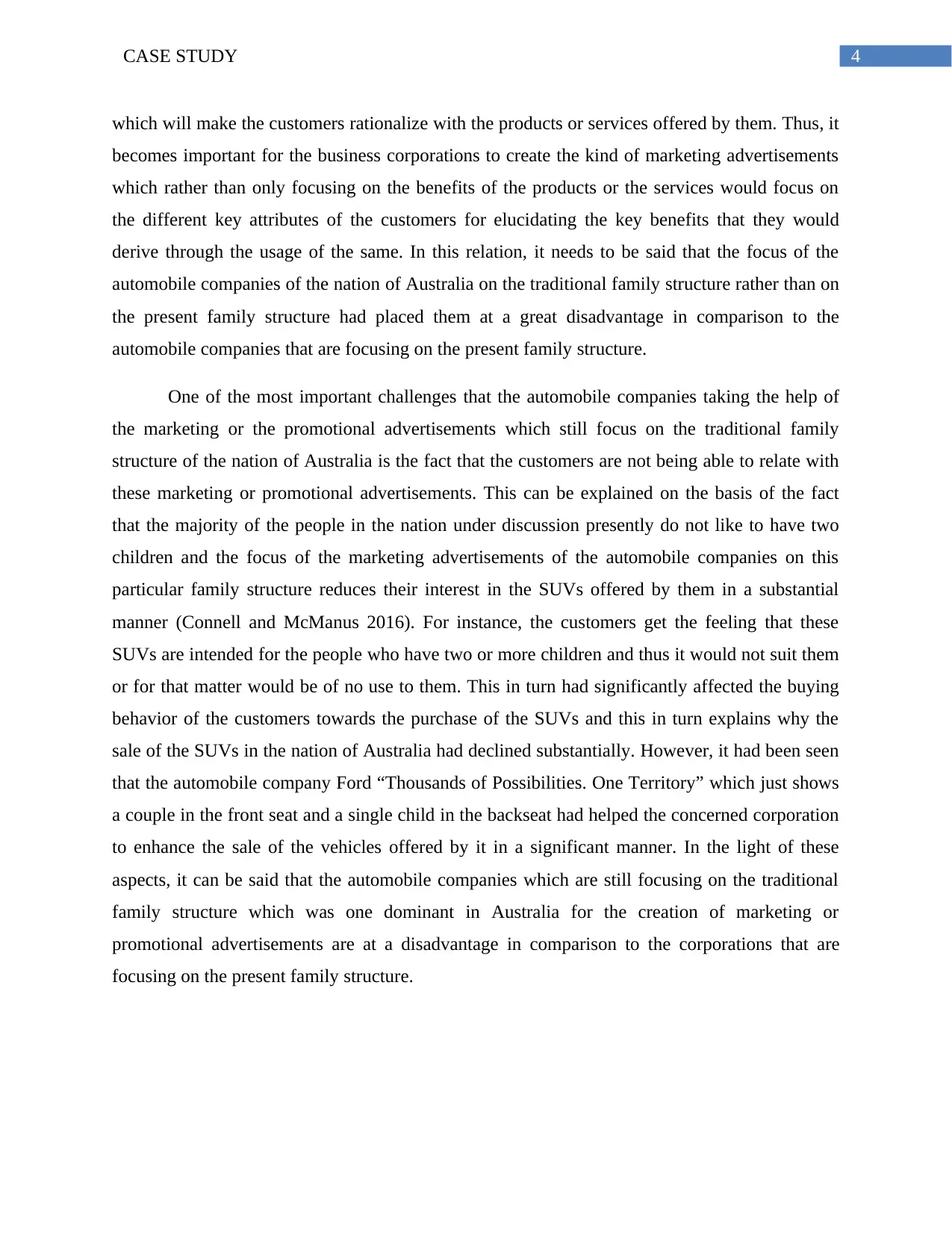
4CASE STUDY
which will make the customers rationalize with the products or services offered by them. Thus, it
becomes important for the business corporations to create the kind of marketing advertisements
which rather than only focusing on the benefits of the products or the services would focus on
the different key attributes of the customers for elucidating the key benefits that they would
derive through the usage of the same. In this relation, it needs to be said that the focus of the
automobile companies of the nation of Australia on the traditional family structure rather than on
the present family structure had placed them at a great disadvantage in comparison to the
automobile companies that are focusing on the present family structure.
One of the most important challenges that the automobile companies taking the help of
the marketing or the promotional advertisements which still focus on the traditional family
structure of the nation of Australia is the fact that the customers are not being able to relate with
these marketing or promotional advertisements. This can be explained on the basis of the fact
that the majority of the people in the nation under discussion presently do not like to have two
children and the focus of the marketing advertisements of the automobile companies on this
particular family structure reduces their interest in the SUVs offered by them in a substantial
manner (Connell and McManus 2016). For instance, the customers get the feeling that these
SUVs are intended for the people who have two or more children and thus it would not suit them
or for that matter would be of no use to them. This in turn had significantly affected the buying
behavior of the customers towards the purchase of the SUVs and this in turn explains why the
sale of the SUVs in the nation of Australia had declined substantially. However, it had been seen
that the automobile company Ford “Thousands of Possibilities. One Territory” which just shows
a couple in the front seat and a single child in the backseat had helped the concerned corporation
to enhance the sale of the vehicles offered by it in a significant manner. In the light of these
aspects, it can be said that the automobile companies which are still focusing on the traditional
family structure which was one dominant in Australia for the creation of marketing or
promotional advertisements are at a disadvantage in comparison to the corporations that are
focusing on the present family structure.
which will make the customers rationalize with the products or services offered by them. Thus, it
becomes important for the business corporations to create the kind of marketing advertisements
which rather than only focusing on the benefits of the products or the services would focus on
the different key attributes of the customers for elucidating the key benefits that they would
derive through the usage of the same. In this relation, it needs to be said that the focus of the
automobile companies of the nation of Australia on the traditional family structure rather than on
the present family structure had placed them at a great disadvantage in comparison to the
automobile companies that are focusing on the present family structure.
One of the most important challenges that the automobile companies taking the help of
the marketing or the promotional advertisements which still focus on the traditional family
structure of the nation of Australia is the fact that the customers are not being able to relate with
these marketing or promotional advertisements. This can be explained on the basis of the fact
that the majority of the people in the nation under discussion presently do not like to have two
children and the focus of the marketing advertisements of the automobile companies on this
particular family structure reduces their interest in the SUVs offered by them in a substantial
manner (Connell and McManus 2016). For instance, the customers get the feeling that these
SUVs are intended for the people who have two or more children and thus it would not suit them
or for that matter would be of no use to them. This in turn had significantly affected the buying
behavior of the customers towards the purchase of the SUVs and this in turn explains why the
sale of the SUVs in the nation of Australia had declined substantially. However, it had been seen
that the automobile company Ford “Thousands of Possibilities. One Territory” which just shows
a couple in the front seat and a single child in the backseat had helped the concerned corporation
to enhance the sale of the vehicles offered by it in a significant manner. In the light of these
aspects, it can be said that the automobile companies which are still focusing on the traditional
family structure which was one dominant in Australia for the creation of marketing or
promotional advertisements are at a disadvantage in comparison to the corporations that are
focusing on the present family structure.
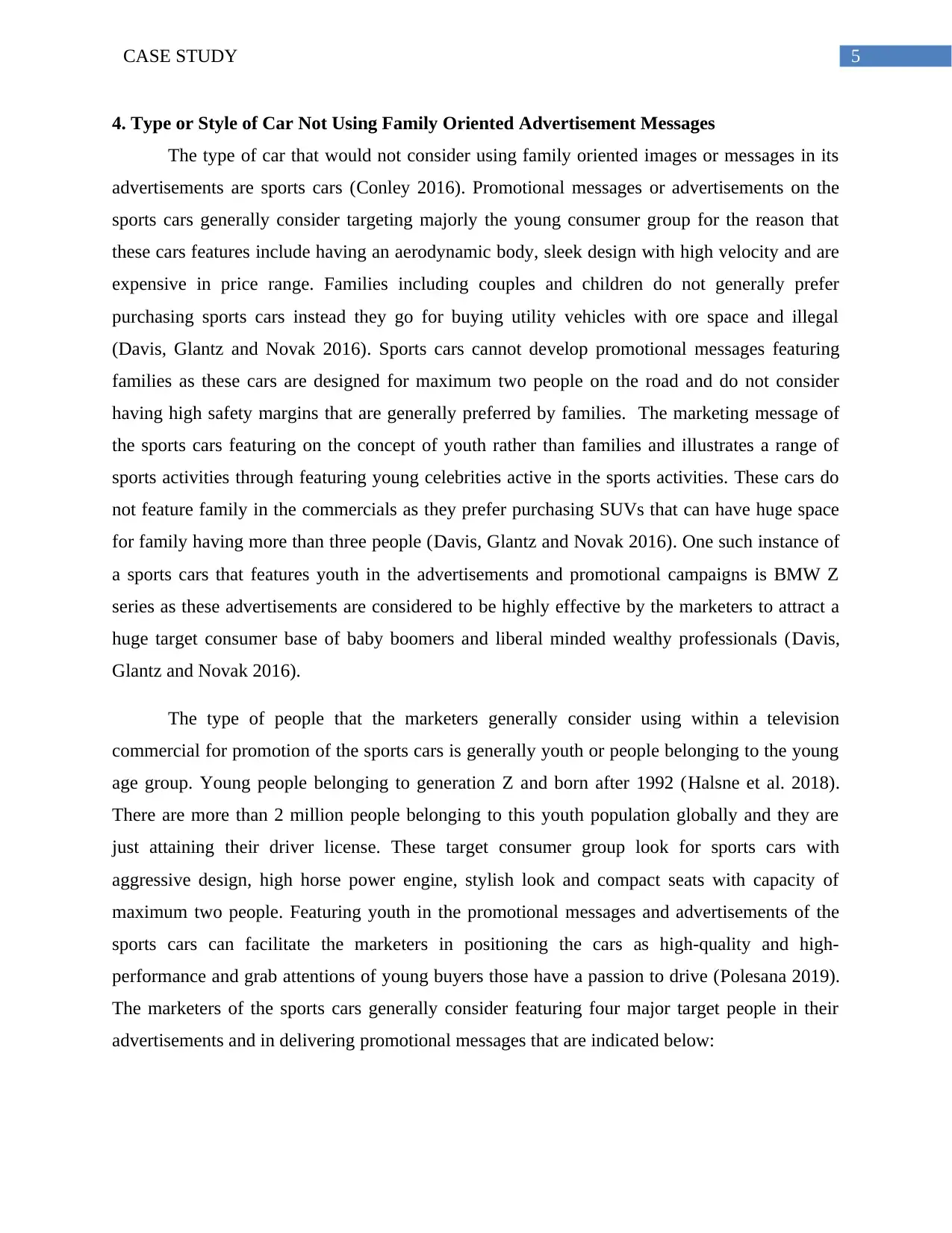
5CASE STUDY
4. Type or Style of Car Not Using Family Oriented Advertisement Messages
The type of car that would not consider using family oriented images or messages in its
advertisements are sports cars (Conley 2016). Promotional messages or advertisements on the
sports cars generally consider targeting majorly the young consumer group for the reason that
these cars features include having an aerodynamic body, sleek design with high velocity and are
expensive in price range. Families including couples and children do not generally prefer
purchasing sports cars instead they go for buying utility vehicles with ore space and illegal
(Davis, Glantz and Novak 2016). Sports cars cannot develop promotional messages featuring
families as these cars are designed for maximum two people on the road and do not consider
having high safety margins that are generally preferred by families. The marketing message of
the sports cars featuring on the concept of youth rather than families and illustrates a range of
sports activities through featuring young celebrities active in the sports activities. These cars do
not feature family in the commercials as they prefer purchasing SUVs that can have huge space
for family having more than three people (Davis, Glantz and Novak 2016). One such instance of
a sports cars that features youth in the advertisements and promotional campaigns is BMW Z
series as these advertisements are considered to be highly effective by the marketers to attract a
huge target consumer base of baby boomers and liberal minded wealthy professionals (Davis,
Glantz and Novak 2016).
The type of people that the marketers generally consider using within a television
commercial for promotion of the sports cars is generally youth or people belonging to the young
age group. Young people belonging to generation Z and born after 1992 (Halsne et al. 2018).
There are more than 2 million people belonging to this youth population globally and they are
just attaining their driver license. These target consumer group look for sports cars with
aggressive design, high horse power engine, stylish look and compact seats with capacity of
maximum two people. Featuring youth in the promotional messages and advertisements of the
sports cars can facilitate the marketers in positioning the cars as high-quality and high-
performance and grab attentions of young buyers those have a passion to drive (Polesana 2019).
The marketers of the sports cars generally consider featuring four major target people in their
advertisements and in delivering promotional messages that are indicated below:
4. Type or Style of Car Not Using Family Oriented Advertisement Messages
The type of car that would not consider using family oriented images or messages in its
advertisements are sports cars (Conley 2016). Promotional messages or advertisements on the
sports cars generally consider targeting majorly the young consumer group for the reason that
these cars features include having an aerodynamic body, sleek design with high velocity and are
expensive in price range. Families including couples and children do not generally prefer
purchasing sports cars instead they go for buying utility vehicles with ore space and illegal
(Davis, Glantz and Novak 2016). Sports cars cannot develop promotional messages featuring
families as these cars are designed for maximum two people on the road and do not consider
having high safety margins that are generally preferred by families. The marketing message of
the sports cars featuring on the concept of youth rather than families and illustrates a range of
sports activities through featuring young celebrities active in the sports activities. These cars do
not feature family in the commercials as they prefer purchasing SUVs that can have huge space
for family having more than three people (Davis, Glantz and Novak 2016). One such instance of
a sports cars that features youth in the advertisements and promotional campaigns is BMW Z
series as these advertisements are considered to be highly effective by the marketers to attract a
huge target consumer base of baby boomers and liberal minded wealthy professionals (Davis,
Glantz and Novak 2016).
The type of people that the marketers generally consider using within a television
commercial for promotion of the sports cars is generally youth or people belonging to the young
age group. Young people belonging to generation Z and born after 1992 (Halsne et al. 2018).
There are more than 2 million people belonging to this youth population globally and they are
just attaining their driver license. These target consumer group look for sports cars with
aggressive design, high horse power engine, stylish look and compact seats with capacity of
maximum two people. Featuring youth in the promotional messages and advertisements of the
sports cars can facilitate the marketers in positioning the cars as high-quality and high-
performance and grab attentions of young buyers those have a passion to drive (Polesana 2019).
The marketers of the sports cars generally consider featuring four major target people in their
advertisements and in delivering promotional messages that are indicated below:
⊘ This is a preview!⊘
Do you want full access?
Subscribe today to unlock all pages.

Trusted by 1+ million students worldwide
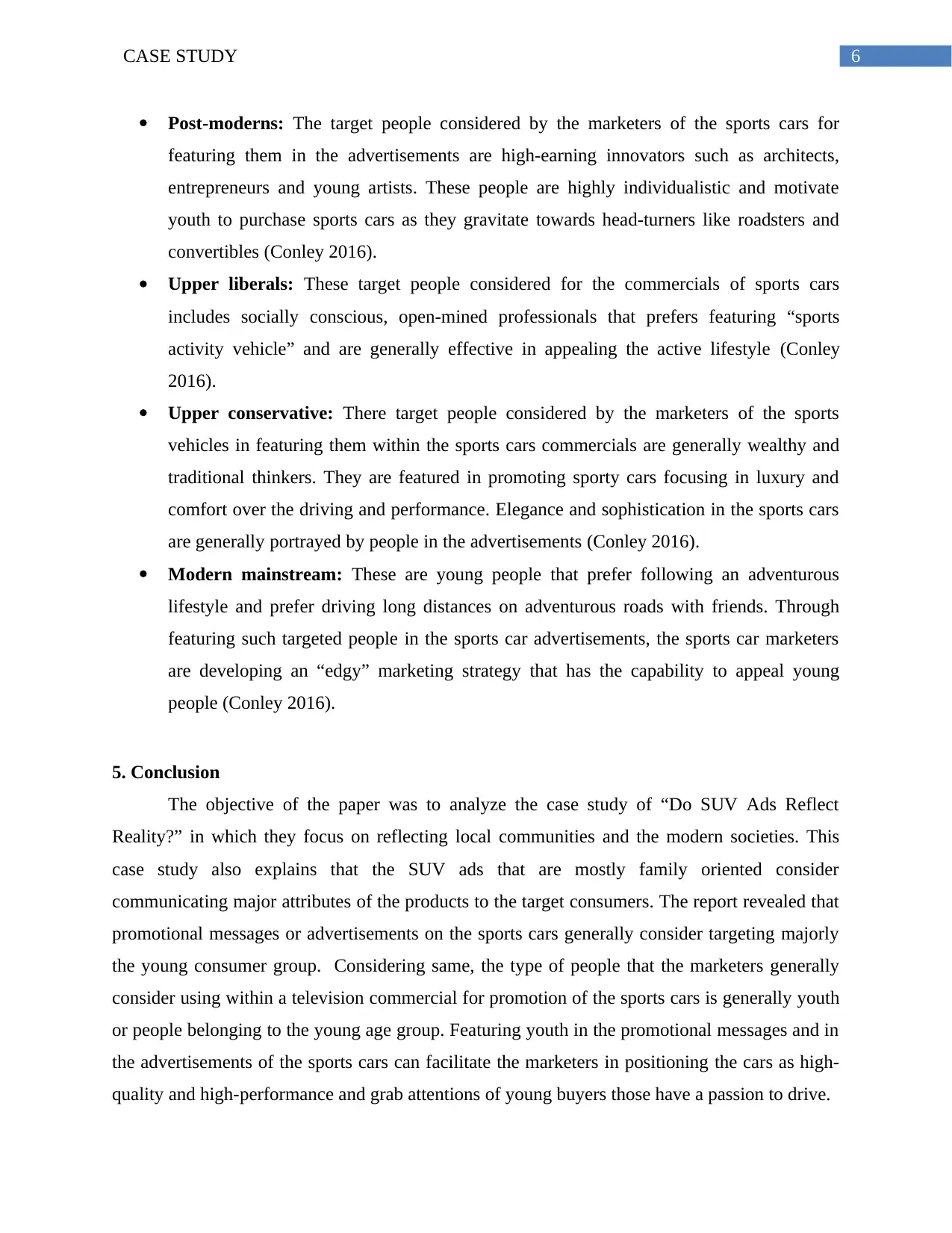
6CASE STUDY
Post-moderns: The target people considered by the marketers of the sports cars for
featuring them in the advertisements are high-earning innovators such as architects,
entrepreneurs and young artists. These people are highly individualistic and motivate
youth to purchase sports cars as they gravitate towards head-turners like roadsters and
convertibles (Conley 2016).
Upper liberals: These target people considered for the commercials of sports cars
includes socially conscious, open-mined professionals that prefers featuring “sports
activity vehicle” and are generally effective in appealing the active lifestyle (Conley
2016).
Upper conservative: There target people considered by the marketers of the sports
vehicles in featuring them within the sports cars commercials are generally wealthy and
traditional thinkers. They are featured in promoting sporty cars focusing in luxury and
comfort over the driving and performance. Elegance and sophistication in the sports cars
are generally portrayed by people in the advertisements (Conley 2016).
Modern mainstream: These are young people that prefer following an adventurous
lifestyle and prefer driving long distances on adventurous roads with friends. Through
featuring such targeted people in the sports car advertisements, the sports car marketers
are developing an “edgy” marketing strategy that has the capability to appeal young
people (Conley 2016).
5. Conclusion
The objective of the paper was to analyze the case study of “Do SUV Ads Reflect
Reality?” in which they focus on reflecting local communities and the modern societies. This
case study also explains that the SUV ads that are mostly family oriented consider
communicating major attributes of the products to the target consumers. The report revealed that
promotional messages or advertisements on the sports cars generally consider targeting majorly
the young consumer group. Considering same, the type of people that the marketers generally
consider using within a television commercial for promotion of the sports cars is generally youth
or people belonging to the young age group. Featuring youth in the promotional messages and in
the advertisements of the sports cars can facilitate the marketers in positioning the cars as high-
quality and high-performance and grab attentions of young buyers those have a passion to drive.
Post-moderns: The target people considered by the marketers of the sports cars for
featuring them in the advertisements are high-earning innovators such as architects,
entrepreneurs and young artists. These people are highly individualistic and motivate
youth to purchase sports cars as they gravitate towards head-turners like roadsters and
convertibles (Conley 2016).
Upper liberals: These target people considered for the commercials of sports cars
includes socially conscious, open-mined professionals that prefers featuring “sports
activity vehicle” and are generally effective in appealing the active lifestyle (Conley
2016).
Upper conservative: There target people considered by the marketers of the sports
vehicles in featuring them within the sports cars commercials are generally wealthy and
traditional thinkers. They are featured in promoting sporty cars focusing in luxury and
comfort over the driving and performance. Elegance and sophistication in the sports cars
are generally portrayed by people in the advertisements (Conley 2016).
Modern mainstream: These are young people that prefer following an adventurous
lifestyle and prefer driving long distances on adventurous roads with friends. Through
featuring such targeted people in the sports car advertisements, the sports car marketers
are developing an “edgy” marketing strategy that has the capability to appeal young
people (Conley 2016).
5. Conclusion
The objective of the paper was to analyze the case study of “Do SUV Ads Reflect
Reality?” in which they focus on reflecting local communities and the modern societies. This
case study also explains that the SUV ads that are mostly family oriented consider
communicating major attributes of the products to the target consumers. The report revealed that
promotional messages or advertisements on the sports cars generally consider targeting majorly
the young consumer group. Considering same, the type of people that the marketers generally
consider using within a television commercial for promotion of the sports cars is generally youth
or people belonging to the young age group. Featuring youth in the promotional messages and in
the advertisements of the sports cars can facilitate the marketers in positioning the cars as high-
quality and high-performance and grab attentions of young buyers those have a passion to drive.
Paraphrase This Document
Need a fresh take? Get an instant paraphrase of this document with our AI Paraphraser
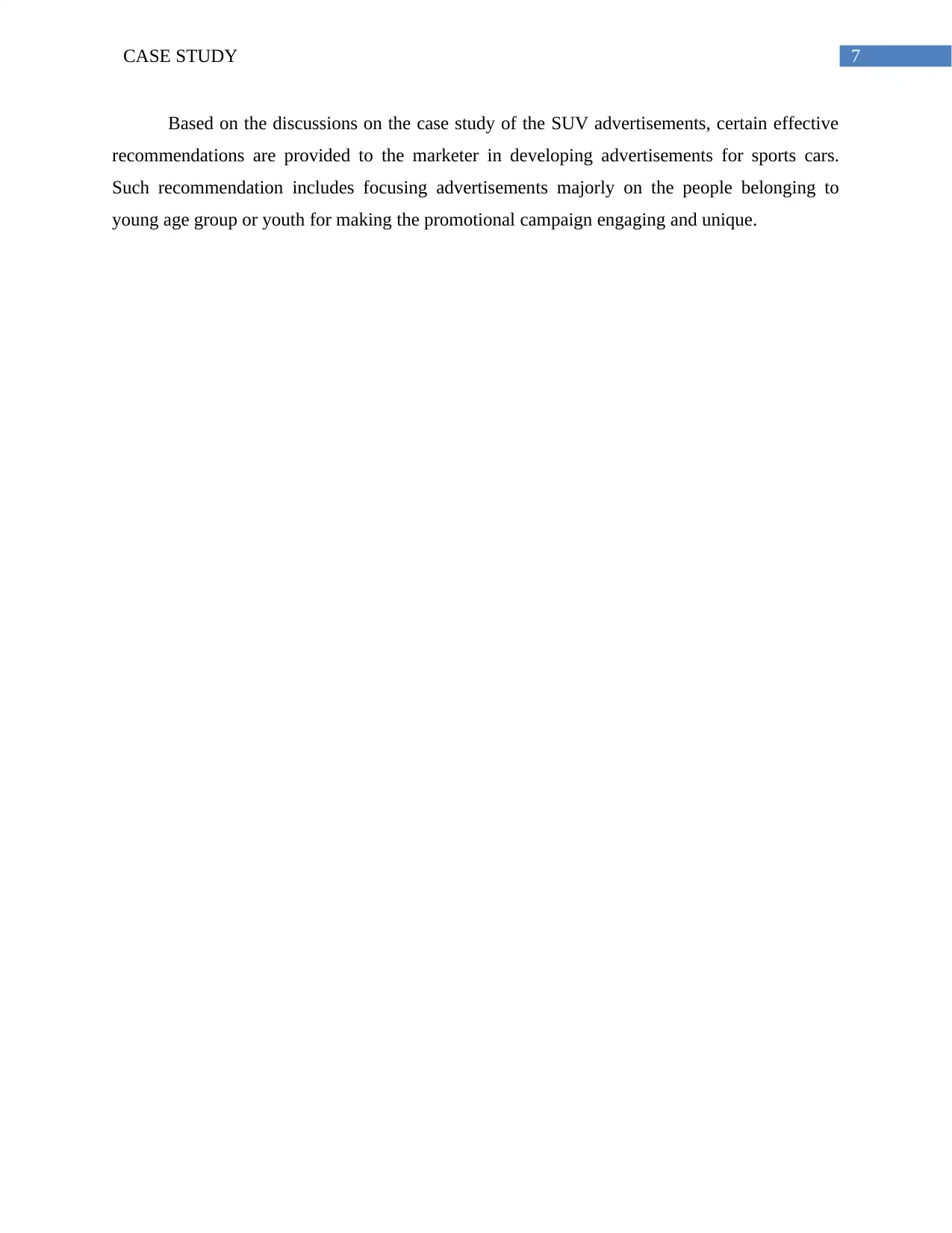
7CASE STUDY
Based on the discussions on the case study of the SUV advertisements, certain effective
recommendations are provided to the marketer in developing advertisements for sports cars.
Such recommendation includes focusing advertisements majorly on the people belonging to
young age group or youth for making the promotional campaign engaging and unique.
Based on the discussions on the case study of the SUV advertisements, certain effective
recommendations are provided to the marketer in developing advertisements for sports cars.
Such recommendation includes focusing advertisements majorly on the people belonging to
young age group or youth for making the promotional campaign engaging and unique.
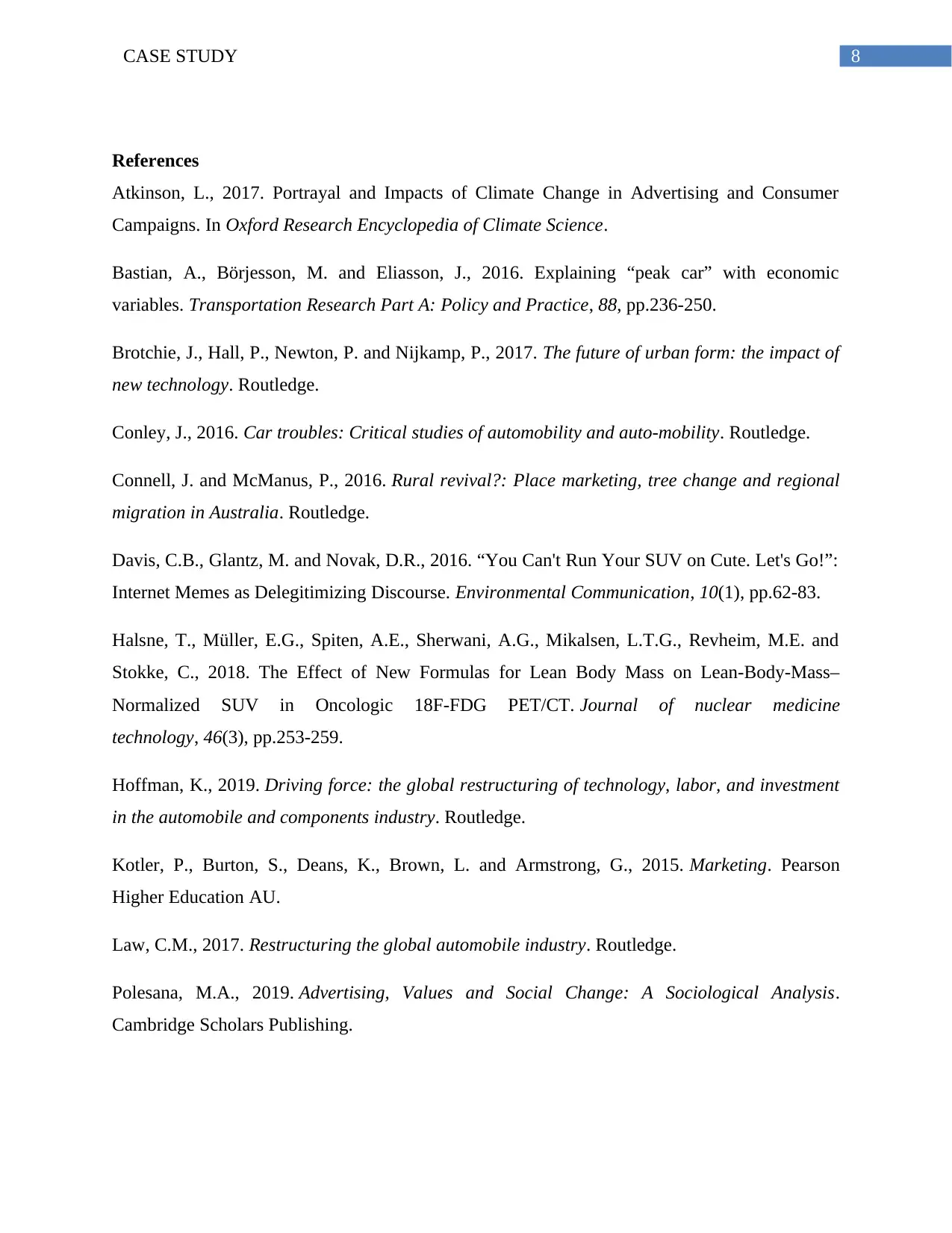
8CASE STUDY
References
Atkinson, L., 2017. Portrayal and Impacts of Climate Change in Advertising and Consumer
Campaigns. In Oxford Research Encyclopedia of Climate Science.
Bastian, A., Börjesson, M. and Eliasson, J., 2016. Explaining “peak car” with economic
variables. Transportation Research Part A: Policy and Practice, 88, pp.236-250.
Brotchie, J., Hall, P., Newton, P. and Nijkamp, P., 2017. The future of urban form: the impact of
new technology. Routledge.
Conley, J., 2016. Car troubles: Critical studies of automobility and auto-mobility. Routledge.
Connell, J. and McManus, P., 2016. Rural revival?: Place marketing, tree change and regional
migration in Australia. Routledge.
Davis, C.B., Glantz, M. and Novak, D.R., 2016. “You Can't Run Your SUV on Cute. Let's Go!”:
Internet Memes as Delegitimizing Discourse. Environmental Communication, 10(1), pp.62-83.
Halsne, T., Müller, E.G., Spiten, A.E., Sherwani, A.G., Mikalsen, L.T.G., Revheim, M.E. and
Stokke, C., 2018. The Effect of New Formulas for Lean Body Mass on Lean-Body-Mass–
Normalized SUV in Oncologic 18F-FDG PET/CT. Journal of nuclear medicine
technology, 46(3), pp.253-259.
Hoffman, K., 2019. Driving force: the global restructuring of technology, labor, and investment
in the automobile and components industry. Routledge.
Kotler, P., Burton, S., Deans, K., Brown, L. and Armstrong, G., 2015. Marketing. Pearson
Higher Education AU.
Law, C.M., 2017. Restructuring the global automobile industry. Routledge.
Polesana, M.A., 2019. Advertising, Values and Social Change: A Sociological Analysis.
Cambridge Scholars Publishing.
References
Atkinson, L., 2017. Portrayal and Impacts of Climate Change in Advertising and Consumer
Campaigns. In Oxford Research Encyclopedia of Climate Science.
Bastian, A., Börjesson, M. and Eliasson, J., 2016. Explaining “peak car” with economic
variables. Transportation Research Part A: Policy and Practice, 88, pp.236-250.
Brotchie, J., Hall, P., Newton, P. and Nijkamp, P., 2017. The future of urban form: the impact of
new technology. Routledge.
Conley, J., 2016. Car troubles: Critical studies of automobility and auto-mobility. Routledge.
Connell, J. and McManus, P., 2016. Rural revival?: Place marketing, tree change and regional
migration in Australia. Routledge.
Davis, C.B., Glantz, M. and Novak, D.R., 2016. “You Can't Run Your SUV on Cute. Let's Go!”:
Internet Memes as Delegitimizing Discourse. Environmental Communication, 10(1), pp.62-83.
Halsne, T., Müller, E.G., Spiten, A.E., Sherwani, A.G., Mikalsen, L.T.G., Revheim, M.E. and
Stokke, C., 2018. The Effect of New Formulas for Lean Body Mass on Lean-Body-Mass–
Normalized SUV in Oncologic 18F-FDG PET/CT. Journal of nuclear medicine
technology, 46(3), pp.253-259.
Hoffman, K., 2019. Driving force: the global restructuring of technology, labor, and investment
in the automobile and components industry. Routledge.
Kotler, P., Burton, S., Deans, K., Brown, L. and Armstrong, G., 2015. Marketing. Pearson
Higher Education AU.
Law, C.M., 2017. Restructuring the global automobile industry. Routledge.
Polesana, M.A., 2019. Advertising, Values and Social Change: A Sociological Analysis.
Cambridge Scholars Publishing.
⊘ This is a preview!⊘
Do you want full access?
Subscribe today to unlock all pages.

Trusted by 1+ million students worldwide
1 out of 9
Related Documents
Your All-in-One AI-Powered Toolkit for Academic Success.
+13062052269
info@desklib.com
Available 24*7 on WhatsApp / Email
![[object Object]](/_next/static/media/star-bottom.7253800d.svg)
Unlock your academic potential
Copyright © 2020–2025 A2Z Services. All Rights Reserved. Developed and managed by ZUCOL.





